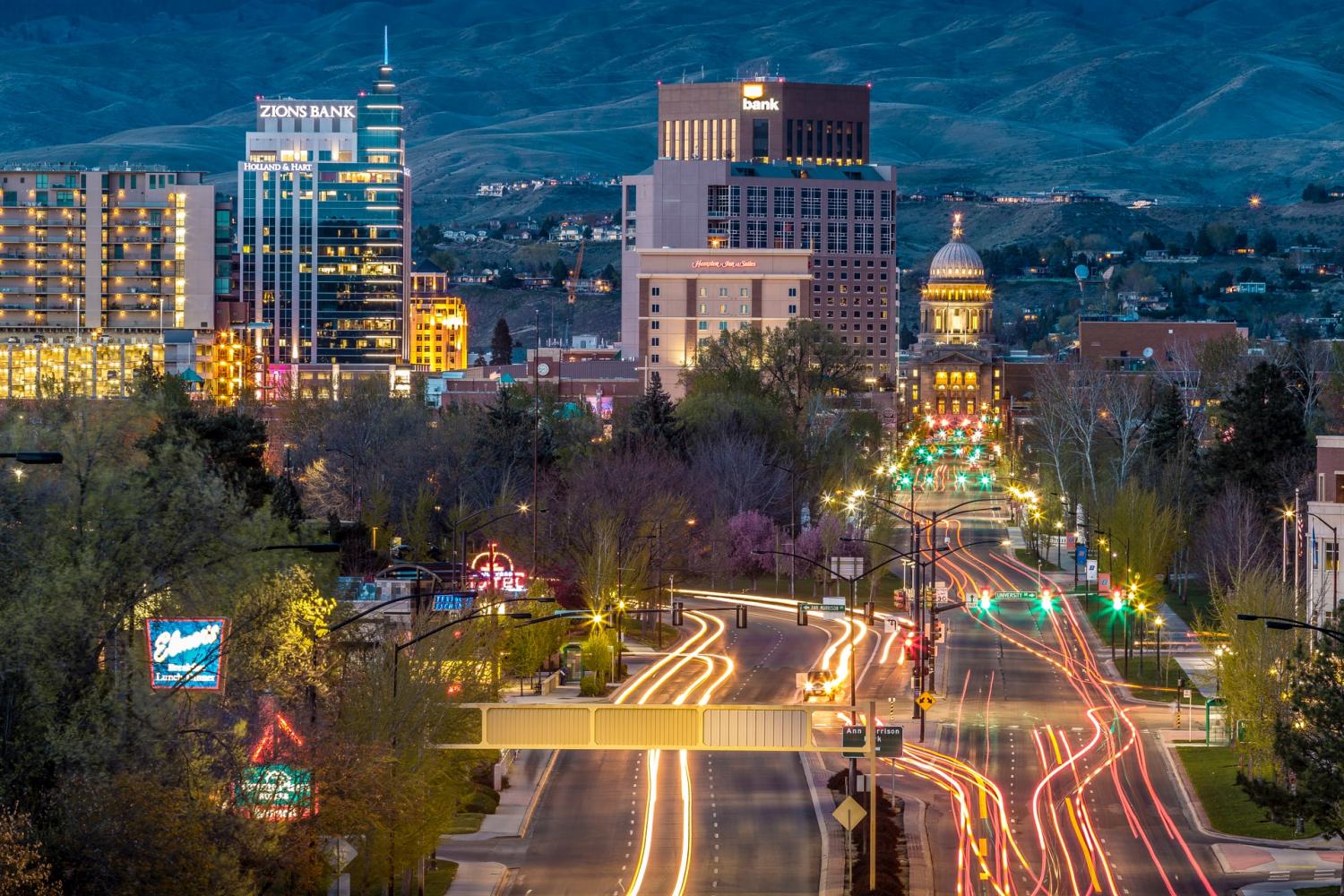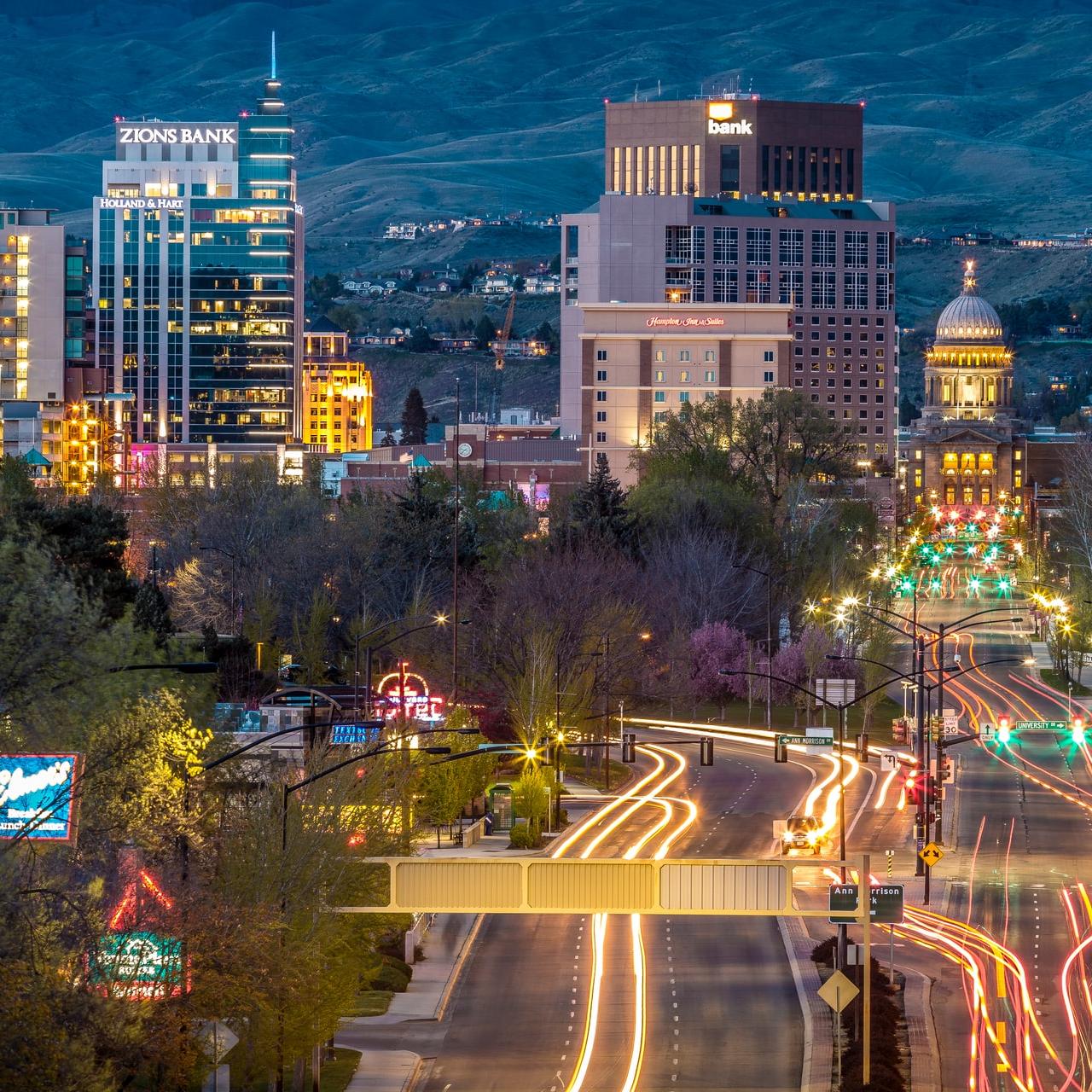Why Business Should Back a Biden Climate Plan


During the George W. Bush presidential administration, I worked for the Government Accountability Office. One project on which I worked was a look at the economic costs and benefits of the U.S. not taking action on climate change. We conducted an iterative survey of some of the leading economists and unsurprisingly, the consensus was that the costs of inaction are much greater than the benefits. And yet, over a decade later, this country has struggled to make a successful economic argument about why we must act on climate change. A thoughtful Biden climate plan can change that trajectory.
We still continue to see increasing the surging economic costs of unchecked climate change, from wildfires to floods to hurricanes. We can now be cautiously optimistic that President-elect Joe Biden is stacking his economic team with climate hawks.
Janet Yellen: from the White House to the Treasury
Take Janet Yellen (pictured above, right, speaking with then-IMF head Christine Lagarde), Biden’s pick for Treasury Secretary. In addition to being the first woman leading the U.S. Treasury in its 231-year history, Yellen has a long history of supporting action on climate change. As a top economic advisor to President Bill Clinton, she saw the risk of climate change to the financial system as far back as the 1990s.
Later, as Chair of the Federal Reserve, she was the first head of that bank to talk about income inequality head on. Further, since stepping down as the Fed’s chair in 2018, she has actively spoken out for a tax on carbon emissions—an policy supported by economists across the political spectrum as the most cost-effective solution to addressing the climate crisis. In fact, she is a founding member of the Climate Leadership Council, which advocates for a carbon tax and is backed by companies like BP, ExxonMobil and Shell. Her perspective could help make a Biden climate plan successful in the long term.
Yellen’s qualifications uniquely place her to tackle the complex nature of the climate problem. She was a top Fed official before, during, and after the Great Recession of 2007-2009 and chair of the Financial Stability Oversight Council, which was set up after the 2008 housing crash to coordinate financial regulations and identify market risks. The incoming administration is going to be faced with the double impact to the economy of COVID and climate change, so having someone at the helm could shorten the ramp up. In addition, as the department in charge of taxes, a closer look at tax credits for clean energy industries like solar power that have been hit hard by the pandemic could be a lifeline should a Biden climate plan be allowed to come to fruition.
Other economic policy picks are also well-placed to help a Biden climate plan succeed: Brian Deese as the director of the National Economic Council and Cecilia Rouse as the first Black American and fourth woman to chair the Council of Economic Advisors (CEA).
While Deese has raised some hackles on the left about his time at BlackRock, an investment firm, it could be argued that his time as head of the financial giant’s sustainable investing work could have given him some deeper insight into risks related to climate change. Further, he has been vocal about prioritizing energy efficiency and electrification - two issues that are absolutely key to tackling climate change.
Cecilia Rouse will come to the CEA from a position as dean of Princeton’s School of Public and International Affairs, but she has long been outspoken about the economics of income inequality. With Rouse in such a prominent position, we can hope that a Biden climate plan can ensure that its economic policies address climate change impacts that disproportionately fall on communities of color and low-income communities.
The economic impacts of a Biden climate plan
Climate change has never been only an environmental issue. Economics have always been at the heart of taking on this huge challenge. Now that we’re seeing the impacts of climate change, the economic reality is much more apparent.
One study found that if global temperatures rise 4.5 degrees Celsius from pre-industrial levels by 2100, the long-term impacts on at least 22 sectors could cost the U.S. $520 billion every year. Another study found that under our current trajectory, the U.S. will suffer the second highest losses of any country in the world except India.
Nevertheless, we don’t have to project to see how much it’s already costing the U.S. According to the National Atmospheric and Oceanic Administration (NOAA), since 1980, there have been 279 weather and climate disasters that have totaled over $1 billion in damages. The sum for all of those disasters combined tops over $1.8 trillion. Climate-minded economic policies are essential to both mitigating future disasters and building resilience to the ones we can’t avoid.
We know that the impacts of climate change are complex and wide-ranging. Taking on that challenge will require policies driving a Biden climate plan to be at the center of the new administration’s plan, one that should focus on creating new investment opportunities while protecting communities and businesses.
Image credit: U.S. Federal Reserve
During This Holiday Season, Essential Workers Still Confront Grinch After Grinch


Essential workers are certainly being celebrated this holiday season. For her family’s final Christmas in the White House, first lady Melania Trump has included a tribute of decorations highlighting frontline workers such as U.S. Postal Service employees and medical professionals. Macy’s unveiled a window display lauding New York City’s essential workers at its flagship Manhattan store. Last month, a brand of boozy seltzer even asked consumers to nominate outstanding essential workers, eight of whom will score free flights on private jets, along with other swag, so they can go home for the holidays.
Yet across the U.S., while many companies reaped record profits during this nine-month pandemic, their frontline employees are still struggling — and many saw their hazard pay and any COVID-related bonuses disappear long before this holiday season.
For example, the consumer rights advocacy group Public Citizen recently crunched the numbers from 15 leading retail corporations. While these same companies reaped close to $15 billion in increased profits this fiscal year compared to 2019, nine of them have ceased offering any boost in their employees’ hourly pay.
In the big picture, some retailers have paid essential workers better than others during this pandemic. The Brookings Institution, for example, called out Best Buy, Home Depot and Target for paying a higher average rate than their peer companies. Overall, however, while many employees are still scraping by, corporate executives are doing quite well — and despite these companies’ communications teams’ best efforts to paint a pretty picture of how essential workers are being treated, the reality is far different.
"A number of companies at the beginning of the pandemic instituted hazard pay. They've almost all stopped," said U.S. Sen. Sherrod Brown of Ohio at a recent Brookings forum. "It's pretty simple: Workers don't need a public relations campaign — they need better pay and better protections on the job."
Some of the problems essential workers face are structural. In New York City, for example, the minimum wage drivers can earn while working for ride-hailing companies is more than $17 an hour, but that rate doesn’t apply to delivery workers. App-based delivery companies Door Dash and Uber told the New York Times that they are offering extra benefits for delivery workers during this crisis, but workers who deliver meals and products by bicycle or car described a far different reality to the newspaper.
Essential workers have won some victories. The United Food and Commercial Workers International Union (UFCW) announced last week it had won retroactive hazard pay for almost 50,000 employees of the large grocer chain ShopRite. But at a time when the weather is getting colder, consumers are growing more impatient and bills upon bills are mounting, the reality for countless essential workers is that their day-to-day experiences are becoming worse, not better. Retailers can do far better than responding with a written pat on the back while only offering a virtual stocking full of coal.
Image credit: The White House/Twitter
Stephen Curry Shoots for a Purpose-Driven Athletic Apparel Brand


Today, Golden State Warriors star Stephen Curry and Under Armour announced the launch of Curry Brand, which the NBA icon and athletic gear company describe as a purpose-driven athletic apparel brand focused on securing fair and equitable access to sports for any young person interested in athletics.
According to a news release from Under Armour, Curry Brand is the first athletic brand that will integrate social impact into its bottom line. This brand says it is aspiring for a world in which the success of any athlete isn’t determined by his or her circumstances.
For Stephen Curry, another slam dunk for social activism
This new brand is the latest chapter in Curry’s long record of social activism, including organizing events in support of the Black Lives Matter movement, speaking out for women’s equality and inclusion, as well as his ongoing push to raise funds and doing his share of work to eliminate infectious diseases.
Under Armour cites a statistic that less than a quarter of kids who live in low-income households are able to participate in youth sports. In addition, the company concludes that the typical child today spends less than three years playing a sport and on average quits by age 11.

The participation of youth in sports has been disrupted by the COVID-19 pandemic. For example, while the San Francisco 49ers football team reaped headlines over the weekend for having to relocate upcoming home games due to a temporary contact sports ban in its home base of Santa Clara County, that same public health order is hitting local youth sports especially hard.
To that end, the partnership between Under Armour and Golden State’s iconic point guard is determined to take on these inequities.
Starting local in Curry’s home base
As a start, the forces behind Curry Brand will work with community-based programs in areas hit the hardest by the COVID-19 pandemic; that will occur through the funding youth sports, contributions of athletic apparel and equipment, and of course building or refurbishing places to play sports safely. Some of the brand’s revenues will be invested in local communities, with projects including the funding of basketball court renovations, offering additional support to schools and community groups, and boosting mentorship by recruiting coaches who can coach future basketball players while helping them become model citizens.
One of Curry Brand’s first initiatives will be a partnership with the Oakland Unified School District to donate both new athletic apparel and sporting equipment for all middle school athletes and coaches within the district. In addition, two local nonprofits will receive funds to groom youth sports coaches across the northern California city. While the city of 430,000 has experienced its share of an economic and real estate boom in recent years, it still struggles with a poverty rate of about 18 percent.
“We have a shared goal of unlocking play for kids, so that became a natural place for us to focus,” Stephen Curry said of this partnership with Under Armour. “I grew up doing a lot of things to give back to the community with my family — and continue that now — while Under Armour has done so much to support athletes around the world.”
Image credit: Under Armour
Pebble Mine Decision Hints at New Ally for Corporate Environmental Activism


Corporate leaders seeking swift action on decarbonization may have a new ally in the U.S. Army Corps of Engineers (USACE). Last week the notorious Pebble Mine project in the Bristol Bay region of Alaska (pictured above) failed to win a key federal permit from USACE, making it the latest in a growing series of high-impact proposals that have failed to overcome bureaucratic hurdles as well as grassroots opposition.
Setting the stage for the defeat of Pebble Mine
As a key permit-issuing office, the U.S. Army Corps of Engineers has played a featured role in the series of defeated or delayed projects — sometimes proactively, and at other times with the force of public action pushing it along.
In a hint of things to come, back in May 2016 USACE denied a permit for a controversial coal export facility in Washington state. In 2016 USACE also touched off a firestorm of criticism when it approved a permit for another high-profile project, the Dakota Access Pipeline. However, a series of legal challenges later forced USACE to reopen the environmental review process for the pipeline, including two days’ worth of public hearings last October.
USACE was also still conducting public hearings on the Keystone XL tar sands oil pipeline in September and October. Former Secretary of State John Kerry effectively killed the project during the Barack Obama administration. Donald Trump pledged to revive it, but has been mired in the review process all during his tenure — and President-elect Joe Biden has already pledged to quash it again.
In addition, earlier this month USACE announced it would hold up a permit for a highly controversial, $9 billion petrochemical facility challenged by environmental organizations in Louisiana, though it has permitted the developer to continue work on stabilizing the site.
This month, USACE also withdrew plans to dredge parts of San Francisco Bay. The plan, which aimed to enable large oil tankers to pass through to refineries, had been met with furious opposition from environmental organizations.
The long road for Pebble Mine, and its developers
The Pebble Mine saga follows a similar trail. The project is aimed at exploiting one of the world’s largest copper-gold-molybdenum porphyry deposits, but critics say it would also cause irreparable damage to wilderness areas and to one of the most important wild salmon fisheries in the world.
The development rights were first secured by the Canadian company Northern Dynasty Minerals back in 2001, with various other firms including Rio Tinto later becoming affiliated with the project.
Fierce criticism of the Pebble Mine proposal by environmental organizations and local stakeholders soon attracted the attention of Tiffany & Co., which staked out a CSR leadership position in the jewelry industry when it publicly criticized the project in 2009.
Rio Tinto also joined the list of corporations signaling distaste for the project. In 2014 Rio Tinto withdrew its equity shares in Northern Dynasty and gifted them to local nonprofits.
The project also flunked an Environmental Protection Agency review in 2014, but as recently as 2018, it seemed headed for a quick review and approval by USACE.
USACE did release its final Environmental Impact Statement on July 24, 2020, but just three days later, the agency issued a public statement emphasizing that an EIS is not a permit to operate.
“The Corps reiterates that the final environmental impact statement (EIS) is not a permit decision and does not authorize operation of the mine,” USACE explained. “…The analysis in the final EIS will be used to determine if Pebble’s preferred alternative is permissible under Section 404 of the Clean Water Act and Section 10 of the Rivers and Harbors Act.”
Apparently that statement was a red flag. On August 24, the office of U.S. Army Public Affairs issued a notice that USACE declined to issue a permit for Pebble Mine under Section 404.
While noting the economic development benefits of the project in terms of extractive activities, Army Public Affairs also noted that “as currently proposed, the project could have substantial environmental impacts within the unique Bristol Bay watershed and lacks adequate compensatory mitigation.”
“…the project, as proposed, would likely result in significant degradation of the environment and would likely result in significant adverse effects on the aquatic system or human environment,” Army Public Affairs continued.
The final hammer came down just last week, on Nov. 25, in the form of a letter from USACE to the Pebble Limited Partnership, posted on the EIS website. The letter reminded the partners that “discharges of fill material from the proposed project would cause unavoidable adverse impacts to aquatic resources which would result in Significant Degradation to aquatic resources.”
The letter also reminded Pebble Limited Partnership that USACE had described mitigation requirements that would compensate for those impacts, which apparently the firm did not address.
“Accordingly, the district engineer is denying your application for a DA permit,” the letter concluded.
A new ally on environmental protection
That is not the end of that. Pebble Limited Partnership has the right to appeal the ruling, and it probably will.
Those hoping for an assist from Tiffany and other leading consumer brands are barking up the wrong tree. If Pebble Limited Partnership loses customers in the jewelry industry, it could easily offset them. In something of an ironic twist, one leading customer could be the clean tech sector, where copper, gold, and molybdenum all feature prominently in solar cells, wind turbines, electric vehicles, batteries and other devices associated with renewable energy and decarbonization.
There is no easy solution, but a strong focus on environmental protection under the incoming Biden administration could have an impact — and USACE could be front and center. It is in a unique position to influence the pace of environmental progress due to its stewardship role over federal facilities, land and waterways.
Despite the Trump administration’s support for mining and fossil energy interests, USACE is a climate-aware agency that claims to have adopted sustainability as its operating principle. The Corps notes that its operations are defined by statue, but it also affirms its active role as an environmental steward, stating that “sustainability is an umbrella concept that encompasses energy, climate change and the environment to ensure today's actions do not negatively impact tomorrow."
USACE’s 2020 Sustainability Report and Implementation Plan strongly suggests it will play an important role in the years to come. The plan outlines specific action steps that are designed to “integrate sustainability more deeply into its mission and the organizational culture with every passing year.”
With the recent selection of Kerry as the special presidential envoy on climate change, USACE could become a crucial ally for business leaders seeking swift, decisive action on decarbonization during the Biden administration.
Image credit: Paxson Woelber/Unsplash
Food Waste Among Materials Harvested in H&M’s Latest Collection


H&M’s latest clothing line, dubbed the “Conscious Exclusive A/W20 Collection,” takes recycling to a new level with a line of clothing and accessories created from materials, including food waste, that had been destined for the trash bin.
Now, food waste is part of the sustainable textiles conversation
Scheduled to be available online today, the collection includes clothing derived from food waste, as well as fabrics created with wood pulp and recycled fibers. Wine byproducts are the ingredients behind the fast fashion giant’s latest vegan leather shoes.
“For A/W20, we really wanted to be trailblazers – pushing the limits of creativity and sustainable fashion – by focusing on waste,” said H&M creative advisor Ann-Sofie Johansson, in a company statement. “Working with this kind of transformation and being able to speak to our customers through beauty, we hope that waste can be part of the future of sustainable fashion.”
If waste-based fashion spurs visions of burlap sack dresses and earrings made from egg cartons, fear not: the collection includes evening gowns, a tuxedo, men’s suits and a shirt. Among the fashionable accessories are necklaces, chokers and shoe clips crafted from recycled metals.
One of the models who showcased the new clothing line is Zinnia Kumar, who also is an ecologist and activist. “As consumers, we will no longer need to differentiate between fashionability and sustainability, as they will become one and the same. As an ecologist working in fashion, this fills me with hope,” Kumar said in a company statement.
A supply chain incorporating more responsibly sourced fibers
The collection includes four materials and processes new to H&M’s sustainable fashion arsenal. Among them are Eastman’s Naia Renew yarn, which contains 60 percent certified wood fiber and 40 percent recycled waste plastic.
In addition, hemp-based fibers come from Agraloop, a company that manufactures textile fibers from fibrous food waste. Agraloop’s fibers in particular stands out as it is a 2018 H&M Foundation Global Change Award first-prize winner. The company’s production process also eliminates greenhouse gas emissions normally resulting from fiber production, upcycles wastewater and generates organic fertilizer.
We aRe SpinDye’s dyed recycled polyester also is part of H&M’s collection. In this process, the recycled material is dyed before becoming fabric. The company says its system uses 75 percent less water and 90 percent fewer chemicals than traditional means. Another process from Made of Air results in sunglasses made from what it says is carbon-negative plastic.
Also adopted by H&M is a way to pull natural and synthetic fibers from textile waste at various stages of the production process offered by Texloop Recycling.
An ongoing shift in the fashion sector
This is H&M’s second line featuring sustainable materials. Four years ago the company launched its Conscious Exclusive collection, which includes clothing and accessories made exclusively from recycled materials.
Numerous other clothing companies also are developing garments from recycled materials. Patagonia famously created a fleece material made from plastic bottles back in 1993 and makes clothing and gear from recycled polyester, down and wool. Waste2Wear boasts haute couture made from recycled plastic bottles; fabric for a single Couture Light dress from the company’s collection reportedly removes 30 PET bottles from the environment. The French company Veja also employs recycled plastic bottles to make sneakers.
Plastics and fabrics already have a close relationship. Currently about 60 to 65 percent of the textiles produced worldwide are synthetics, most of which are made of the same material as the one for single-use plastics.
H&M insists it continues to deepen its commitment to sustainability. For the past seven years, the owners of the H&M Group, the Stefan Persson family, has been donating to the H&M Foundation to help the company meet the 2030 deadline of Sustainable Development Goals (SDGs) drawn up by the United Nations.
"We take our responsibility to stay within the planetary boundaries very seriously and have an ambitious plan: to become climate positive by 2040 and to only work with sustainably sourced materials by 2030," said Johansson in a recent Forbes article.
Image credit: H&M
Giving Tuesday a Wake-Up Call that Traditional Philanthropy Is Broken


Don’t get me wrong, any dollar spent on a good cause is a dollar well spent. But can we seriously embrace holidays like Giving Tuesday as a solution to the world’s most pressing challenges or is it more about alleviating guilt?
If it’s about alleviating the guilt of having more than we need, then I have no qualms with that approach. But if it's about trying to create substantial change — it’s time to reset and restart.
The numbers illustrate the truth of the matter. At first glance, the $511 million generated on Giving Tuesday in 2019 looks impressive. It’s a significant source of capital that has the potential to help many people when directed to the right causes and organizations.
But compared to the $7.4 billion generated during Black Friday, the $9.4 billion generated on Cyber Monday, and the $74.1 billion on Singles’ Day in China, the millions generated on Giving Tuesday is a pittance — only 0.07 percent of what’s generated from these consumer-crazed spending holidays.
Is the wellbeing of our communities really only worth less than one-tenth of one percent? Giving Tuesday is a nice gesture, but the reality is that climate change, social inequality, and food insecurity cost billions or even trillions of dollars to solve.
We know these social and environmental problems are counterproductive to economic growth. Federal Reserve Chairman Jerome Powell has warned the U.S. that income inequality holds back the economy. The economic toll of the wildfires across California this year is estimated at $10 billion thus far. Isn’t there a better way to address these challenges while simultaneously driving economic growth?
While we can respect the role of philanthropy in society, we must accept that philanthropy isn’t going to cure society’s biggest problems. Meanwhile, it has become blatantly clear that the government will not save us. It’s no surprise that Americans are turning to corporations instead of the U.S. Congress to solve social problems.
It’s time for a better way — a way in which doing good and doing well are not mutually exclusive, but rather mutually reinforcing. There is an opportunity for the business community to make meaningful progress by driving growth and sales through social impact.
Instead of thinking about driving sales and improving society’s wellbeing as separate activities, (Black Friday versus Giving Tuesday) what if we reimagined the sales process so that just 0.25 percent of every sale generated a positive social impact?
Companies are already spending a significant portion of their profits in effort to sell more of their products and services. In fact, companies spend 25 percent of their revenue on selling, general and administrative expenses, in which the majority is related to selling, commissions, advertising, promotions and travel. These traditional client acquisition tactics are not only costly, but oftentimes, they have little to no return on investment.
To be clear, this approach is not a donation tax incentive. Instead, it’s a new and more effective use of client acquisition costs to close sales and strengthen relationships with existing customers. In addition to improving win rates and customer retention, the act of sharing the story of the social impact with employees, consumers, investors, and other key stakeholders can generate value for various departments within both organizations.
This is the change we need to make stakeholder capitalism a reality.
Considering global business transactions add up to roughly $96 trillion each year, the opportunity to drive change at scale is immense. If just 1 percent of the total global transactions adopted this sales model, and attached impact equivalent to 0.25 percent of their sales, it would generate $2.4 Billion to address the needs of society and the planet.
This year, Giving Tuesday isn’t just a reminder to celebrate generosity, it’s a wake-up call that traditional philanthropy is broken. It’s time for business to do what it does best — innovate with urgency — to create a more prosperous future for all. Not only because it is the right thing to do, but because it’s in corporate America’s best interest, too. And that is a step in the right direction.
Images credits: GivingTuesday.org
Morningstar Integrates ESG Factors Into Analyses, Empowers Investors


At long last, the investing research firm Morningstar has formally integrated environmental, social and corporate governance (ESG) factors into its stock, fund, and asset manager analyses using a framework that will capture ESG risks across over 1,500 stocks.
Morningstar doubles down on sustainability
Morningstar had already included ESG risks within its analyses, Adam Fleck, the company’s regional director of equity research, told Stockhead. It became time, however, for the firm to capture those factors in a more formal and consistent fashion, he said. “We were afraid [including ESG factors] outside our core process would miss an opportunity to integrate it into [the] traditional realm of long-term valuation based investing,” Fleck explained. “We’re not going to be launching another separate rating within Morningstar equity research. It’s going to be integrated into principally the moat rating, their competitive advantage, and our uncertainty rating.”
Morningstar’s development is representative of a worldwide increase in fervency toward sustainability, even during the coronavirus pandemic when nations and businesses have new contingencies to grapple with.
The firm will use data from ESG ratings and research company Sustainalytics, acquired by Morningstar in June, to create informed analyses built around 20 material ESG issues, including the environmental and social impact of products and services, occupational health and safety, human rights, and resource use in supply chains. Morningstar will then use this data to analyze how ESG risks could materialize and impact a company’s valuation. The result is a five-star stock rating system with ESG factors fully integrated. Asset managers and strategies are rated on a four-point scale.
Not a move away from financial returns
Integrating ESG metrics does not indicate that Morningstar has strayed from its focus on financial returns, Fleck emphasized to Stockhead. Morningstar simply recognizes that ESG analysis is now essential information for long-term investors, he said — and that’s because a company’s ESG-related commitments and actions are intrinsically connected to its cash flow and success, a pattern that investors are recognizing now more than ever.
While 2020 was a troubling year for the global economy, as the coronavirus pandemic has slowed overall activity, both ESG innovation and investment have still increased. The exacerbation of health and equity crises have been coupled with racial injustices and protests and unprecedented wildfires across the western United States. The events of this year have carried reverberations across the global consciousness — and they haven’t fallen under the radar of investors.
“Over $19 billion has flowed into ESG [exchange-traded funds] this year, bringing the total to over $40 billion,” Luke Oliver, head of index investing for the Americas at DWS Group, told CNBC’s ETF Edge. “Just to put that in some context, there was less than $8 billion in inflow last year, and prior to that the flows were very scant.”
“There’s a capitalist endeavor behind E, S and G, because they give you companies that are better-prepared” for the future, Oliver told CNBC.
Investors can make a mark on ESG progress
In an attempt to make wiser decisions, large investment groups have been putting companies on notice for ESG issues, including workplace equity and climate action. Investors recognize that they are specially positioned to compel companies to change course.
One case of success is with deforestation. The sustainability advocacy nonprofit Ceres reports that 51 shareholder proposals were filed by U.S. investors between 2011 and 2017, asking corporations to adjust their relationship to unsustainable palm oil and other deforestation-related commodities. According to Ceres, 23 companies responded with measurable actions and significant economic impact. The not-for-profit environmental reporting charity CDP estimates up to $906 billion in annual corporate turnover could be at risk due to deforestation.
Where Morningstar fits into this picture of positive investor influence is in its purpose to bring investment research to the average shareholder. Its updated rating system puts power into the hands of the ordinary individual to make wise investment decisions for their own portfolio and for the resiliency of the world. The company operates in 27 countries, and millions of people use its resources.
These days, a corporate environmental, social or governance commitment is a dime a dozen. Sifting through empty promises and measurable impacts can be impossible without insider information. Morningstar’s ESG-integrated rating system brings transparency to the process and empowers the average investor in what feels so often like an otherwise chaotic time.
Image credit: Markus Spiske/Unsplash
The Holidays Offer Yet Another Reminder About Food Waste, and Companies Are Responding in Kind


Whether you braved the holiday weekend passing through airports, or took local guidelines or the CDC’s advice about Thanksgiving gatherings seriously, it’s clear that this is a holiday season like no other. Yet as always, food waste is still top of mind for many organizations, and increasingly more consumers, during this time of year.
Some of the recent news around food waste this fall has been on the grisly side: With more Americans staying home to cook, turkey fails appear to have surged this year. Just about every family with means who are staying home for the holidays will struggle with food waste, and much of that is tied to that favorite holiday icon, the turkey.
The Natural Resources Defense Council (NRDC) is one environmental organization that, year after year, points out the waste linked to the copious amount of food cooked for the Thanksgiving holiday. The group’s researchers have estimated that families toss out 200 million pounds of turkey during this time of year. To put that into perspective, the NRDC says that food waste is equivalent to letting the faucet run for six hours; and in addition to that water waste, the amount of energy consumed by all that wasted food is equivalent to the population of Jacksonville, Florida, getting into their cars and going on a road trip to San Francisco.
One way to tackle the food waste problem is to decide on vegetarian options. With more animal protein wasted comes more carbon emissions and water consumption — hence in general, the science agrees that a plant-based diet can help curb the effects the global food and agriculture sector has on the planet.
With anywhere from 30 to 40 percent of all food wasted, more food companies are realizing that a more responsible supply chain, along with cajoling its consumers to change their habits, can help boost their sustainability credentials.
Earlier this month, for example, Unilever announced it would become more aggressive in tackling food waste across its operations. The company said it would strive to halve the food waste generated from factory to shelves by 2025, five years earlier than the fast-moving consumer goods giant originally planned.
And while not entirely a food company, Ikea said it would also work on taking on food waste across the 420 restaurants it operates worldwide.
While they do not link food waste to the providing of more vegan and vegetarian options explicitly, both companies have made it clear that one goal cannot be tackled without the other. Unilever has announced its food waste goal aligns with its objective to generate more than $1 billion in revenues from plant-based foods in five to seven years. And Ikea, home to the famous Swedish meatballs, said half of the meals offered in its cafes will be plant-based by 2025. Both companies have reiterated their pledges to reduce food waste at the same time they announced these objectives. Now comes the hard part: convincing consumers to buy those plant-based meat and dairy alternatives.
Image credit: Mike Von/Unsplash
Sustainability Reporting is Becoming More Streamlined


More companies are buying into sustainability reporting, but one common complaint is that with all the various frameworks, deciding on which one to use — or for many companies, which ones — can be bewildering.
Although sustainability leaders including the outgoing head of the Global Reporting Initiative (GRI), Tim Mohin, have insisted that the "perception" of issuing sustainability reports is more complicated than the process is in reality, many in the corporate reporting world still see all the various standards as overwhelming as they are complex.
News from last week may be welcomed by those in the environmental, social and governance (ESG) space, however.
The International Integrated Reporting Council (IIRC) and the Sustainability Accounting Standards Board (SASB) have announced that they will merge into one sustainability reporting organization, the Value Reporting Foundation.
“The merger directly responds to calls from global investors and corporates to simplify the corporate reporting landscape, providing the market with a clear solution for communicating about the drivers of enterprise value,” said the two organizations in a joint e-mailed statement.
According to both IIRC and SASB, there is already strong alignment between the two groups’ reporting guidelines. But in the wake of an upcoming regime change in the U.S. that some observers say could result in ESG and sustainability funds becoming even more compelling to investors, intertwining these two sustainability reporting standards could make vetting companies across the globe more seamless.
Global inflows into ESG funds have surged in 2020 despite the global pandemic and economic crises, and the amount of assets held in socially conscious or impact funds have soared to $250 billion in the past quarter. But with such growth also comes more confusion, along with research indicating that companies can cherry-pick which ESG guidelines they wish to follow. One ESG research firm’s conclusion can vary from another’s, especially when it comes to comparing companies that are in different industries. An energy company may look spectacular on the sustainability reporting front when compared to its competitors, but it could pale when its numbers are lined up next to a corporation in the fast-moving goods sector.
In fairness, sustainability reporting is still a relatively new field, and the new Value Reporting Foundation has made it clear its framework will hardly be static. “This merger is a significant advancement toward building a comprehensive system of corporate reporting, as we work to ensure integrated reporting and sustainability disclosure have the same level of rigor as financial accounting and disclosure,” said Charles Tilley, CEO of IIRC. “But reporting should never be for reporting’s sake. Our focus is on ensuring businesses have effective governance over enterprise value creation factors and that investors are able to fulfill their role as stewards.”
Image credit: Karen Uppal/Unsplash
Uncharted Territory in COVID-19 Crisis: Thanksgiving Travel Muddies the Mask Mandate Waters


As millions of Americans ignore public health warnings to travel over the Thanksgiving holiday, it’s worth remembering that the health and safety of millions more is in the hands of state governors and legislators who have failed to establish life-saving mask mandates to prevent the spread of COVID-19. Instead, local business leaders are left to their own devices, pleading with their communities - and those who insist on their Thanksgiving travel plans - to simply wear a mask.
The curious case of Idaho
Some governors have ramped up statewide COVID-19 prevention rules in advance of the Thanksgiving travel season.
However, in the absence of national leadership on universal mask wearing, the patchwork of state-based efforts has fallen far short.
The state of Idaho is a case in point. All during the COVID-19 outbreak, Idaho Governor Brad Little has resisted calls for a statewide mask mandate. Even as cases have spiked in Idaho and nationwide in the runup to the Thanksgiving travel season, Little has continued to advocate for voluntary mask wearing, leaving mandates up to local governments and health districts.
By November 13 the state’s healthcare system was already nearing a crisis, partly because many health care workers were out sick or quarantined.
Little did reimpose some restrictions on social gatherings on November 13, and he called up the National Guard to assist with screening and testing. However, he still failed to make mask wearing mandatory statewide.
By November 22, the local television station KTVB reported that the state’s two-week rolling average of new cases had increased to 1,358. There appears to be no end in sight. On November 23 KTVB reported an additional 1,437 new confirmed cases, and 190 new probable cases.
Local business leaders plead for help confronting COVID-19
As the Thanksgiving travel season began to get under way last Friday, a group of 12 Idaho CEO’s issued a public plea for universal mask wearing.
“The recent surge in cases is overrunning our hospitals and clinics,” they wrote. “The pandemic has had a significant impact on our economy, our education systems, and our own mental health. We all want things to be normal; coming together to overcome this incredible obstacle is the only way to get there.”
The CEO’s also describe the mask mandates and other COVID-19 prevention measures they have established to protect their workers, emphasizing that their own experience demonstrates that “consistently following simple safety practices can prevent infections and keep businesses running.”
Unfortunately, a mere letter is no match for the attention-grabbing actions of anti-mask protestors, who have been especially active in Idaho.
Among the instigators is Ammon Bundy, a nationally known figure whose purported advocacy for civil disobedience took form during an armed takeover of the Malheur National Wildlife Refuge in Oregon, in 2016.
Such behavior has been encouraged by President Trump, whose campaign schedule in the runup to Election Day has been described as a weeks-long series of COIVD-19 super-spreader events.
As Thanksgiving travel goes unabated, give thanks for masks
The CEO letter does raise a point about the ability of individuals to foster the public welfare through their personal choices, and there are some interesting parallels with action on climate change.
One of those parallels is a federal leadership vacuum. In the case of COVID-19, President Trump’s failure to lead a national COVID-19 response has left CEOs howling into the wind. The Thanksgiving travel decisions of millions of Americans have only added to the disconnect.
On the positive side, the incoming Biden administration is taking federal responsibility seriously, and there is increasing evidence that universal mask wearing has bottom line benefits.
For example, a new study from the University of Utah concludes that improvements in economic activity during the COVID-19 outbreak are linked to masks mandates.
“County-level data from across the U.S. show COVID-19 cases decrease after a mask requirement is put into place,” the researchers summarized, linking that data to a consumer survey.
“A Utah consumer sentiment survey conducted as part of this study found people would be 13 percent more likely to go to a store if confirmed COVID-19 cases fell by 10 percent,” they wrote. “The survey also found people would be 51% more likely to go to a store if everyone was wearing a mask (this percent increase is similar to if a store or the state enforced mask-wearing).”
In the waning days of the Trump administration, the president is unlikely to change direction on COVID-19.
The opportunity to practice COVID-19 safety in advance of the Thanksgiving travel season has been lost, but perhaps the incoming Biden administration can work with US business leaders to prevent further tragedy from striking over the Christmas holidays.
Image credit of Boise, Idaho: Alden Skeie/Unsplash